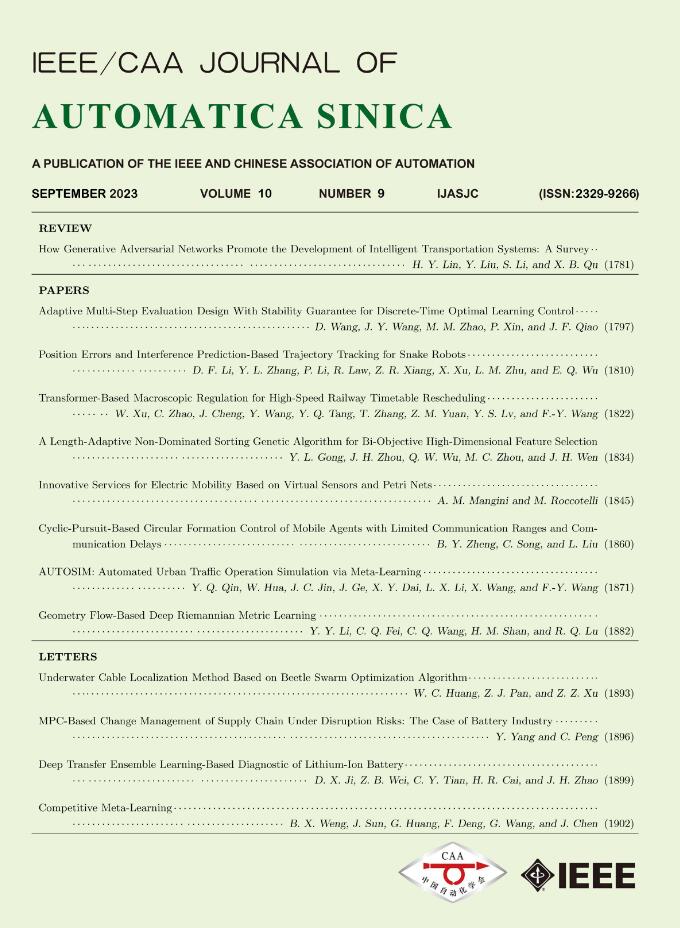 Volume 10
Issue 9
Volume 10
Issue 9
IEEE/CAA Journal of Automatica Sinica
| Citation: | Y. Yang and C. Peng, “MPC-based change management of supply chain under disruption risks: The case of battery industry,” IEEE/CAA J. Autom. Sinica, vol. 10, no. 9, pp. 1896–1898, Sept. 2023. doi: 10.1109/JAS.2023.123294 |

| [1] |
K. Liu, Z. Wei, C. Zhang, Y. Shang, R. Teodorescu, and Q.-L. Han, “Towards long lifetime battery: AI-based manufacturing and management,” IEEE/CAA J. Autom. Sinica, vol. 9, no. 7, pp. 1139–1165, 2022. doi: 10.1109/JAS.2022.105599
|
| [2] |
Y. Todo, K. Nakajima, and P. Matous, “How do supply chain networks affect the resilience of firms to natural disasters? Evidence from the great east Japan earthquake,” J. Regional Sci., vol. 55, no. 2, pp. 209–229, 2015. doi: 10.1111/jors.12119
|
| [3] |
M. Queiroz, D. Ivanov, A. Dolgui, and S. Wamba, “Impacts of epidemic outbreaks on supply chains: Mapping a research agenda amid the COVID-19 pandemic through a structured literature review,” Anna. Oper Rese., vol. 319, no. 1, pp. 1159–1196, 2022.
|
| [4] |
S. Paul and P. Chowdhury, “A production recovery plan in manufacturing supply chains for a high-demand item during COVID-19,” Int. J. Phys. Distr. &Log., vol. 51, no. 2, pp. 104–125, 2020.
|
| [5] |
J. Chen, H. Wang, and R. Zhong, “A supply chain disruption recovery strategy considering product change under COVID-19,” J. Manuf. Syst., vol. 60, pp. 920–927, 2021. doi: 10.1016/j.jmsy.2021.04.004
|
| [6] |
N. Darom, H. Hishamuddin, R. Ramli, and Z. Nopiah, “An inventory model of supply chain disruption recovery with safety stock and carbon emission consideration,” J. Clean. Prod., vol. 197, no. 1, pp. 1011–1021, 2018.
|
| [7] |
G. Rainisch, E. Undurraga, and G. Chowell, “A dynamic modeling tool for estimating healthcare demand from the COVID-19 epidemic and evaluating population-wide interventions,” Int. J. Infect. Dis., vol. 96, pp. 376–383, 2020. doi: 10.1016/j.ijid.2020.05.043
|
| [8] |
Y. Xi, D. Li, and S. Lin, “Model predictive control-status and challenges,” Acta Autom. Sinica, vol. 39, no. 3, pp. 222–236, 2013. doi: 10.1016/S1874-1029(13)60024-5
|
| [9] |
J. Schwartz, W. Wang, and D. Rivera, “Simulation-based optimization of process control policies for inventory management in supply chains,” Autom., vol. 42, no. 8, pp. 1311–1320, 2006. doi: 10.1016/j.automatica.2006.03.019
|
| [10] |
J. Maestre, M. Fernández, and I. Jurado, “An application of economic model predictive control to inventory management in hospitals,” Control Eng. Pract., vol. 71, pp. 120–128, 2018. doi: 10.1016/j.conengprac.2017.10.012
|
| [11] |
Y. Yang, C. Peng, and Q. Li, “Predictive control of inventory management in supply chain systems with uncertain demands and time delays,” in Proc. 40th IEEE Chinese Control Conf., 2021, pp. 450–455.
|